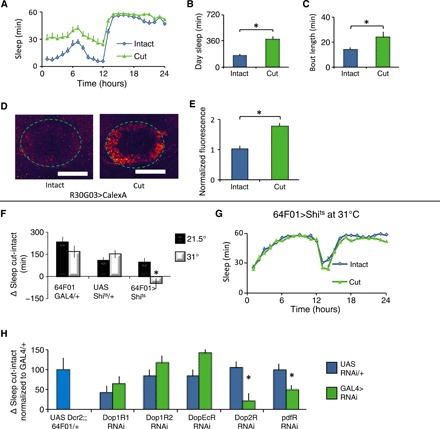Fig. 4. Cutting wings increases sleep.

(A) Flies slept more the second day following wing cut than age-matched controls (n = 32 flies per condition; repeated-measures ANOVA for Time × Condition, P < 0.001). (B and C) Flies with cut wings displayed increased daytime sleep and sleep bout duration compared to controls (t test, *P < 0.001). (D) Representative images of R30G03-GAL4/+>CalexA/+ with intact and cut wings. (E) Quantification of CaLexA. Signal was higher in brains of flies with cut wings compared to controls (n = 8 to 9 flies per condition; *P < 0.001, t test). (F) Silencing R64F01-GAL4/+>UAS-shits1/+ neurons by raising the temperature from 21.5° to 31°C blocked the increase in sleep following wing cut. Sleep is expressed as a change in sleep in cut versus intact siblings (n = 16 flies per genotype per condition; *P < 0.01, Tukey correction). (G) Sleep in minutes per hour for R64F01-GAL4/+>UAS-shits1/+ flies shown in (F). (H) R64F01-GAL4/+>UAS-Dop2RRNAi/+ and R64F01-GAL4/+>UAS-PdfrRNAi/+ flies displayed an attenuated change in sleep following wing cut; R64F01-GAL4/+>UAS-Dop1R1RNAi/+, R64F01-GAL4/+>UAS-Dop1R2RNAi/+, and R64F01-GAL4/+>UAS-DopEcrRNAi/+ were not different from controls (n = 16 to 32 flies per genotype; *P < 0.05, Tukey correction).
